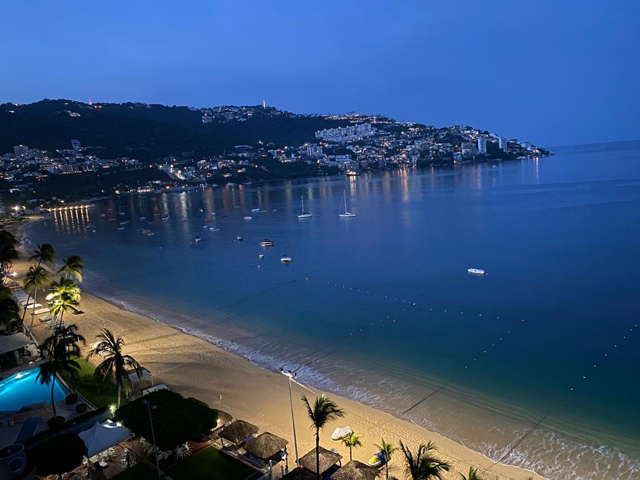27 September 2022–Trapped inside the shoreline of a bay, the resonant interactions of a tsunami with regular waves can prolong the tsunami disturbance. For the 2021 magnitude 7 Acapulco, Mexico earthquake and tsunami, edge waves in the bay and the short continental shelf also had a surprisingly significant effect on the tsunami’s duration, according to a new study published in the Bulletin of the Seismological Society of America.
In the study, Diego Melgar of the University of Oregon and colleagues from research institutions in Mexico, Iceland and the United States developed a slip model for the earthquake that they used to model the tsunami and learn more about why it lasted almost 17 hours inside the bay.
Edge waves—the coastal waves generated by a tsunami that travel back and forth parallel to a shoreline—and the energy generated by waves bouncing off the short continental shelf helped to continuously re-excite the bay resonance, the researchers found.
“The tsunami lasts as long as it does because the bay sloshes it around like a bathtub, but also whatever is going on in the shelf sort of gives it a whack every couple of oscillations and keeps it going,” Melgar explained.
Although previous models suggested that a continental shelf might contribute to tsunami waves in a bay, it was somewhat surprising that such a short shelf—the drop-off to the deep ocean occurs close to shore—would have a notable impact.
“It’s a second-order effect that makes a bad problem slightly worse,” said Melgar. “Every bay needs to think about these problems, and they’re probably going to be worse in places where the shelf is longer and there’s the chance to trap these waves in there.”

In the first tens of minutes of the event, uplift caused by the earthquake “flushed” out the bay at the same time tsunami waves were rushing in. The mix caused hazardous rip currents with speeds up to three kilometers per hour in certain areas.
“Sometimes in Mexico we give the ‘all-clear’ signal after a tsunami that applies to big waves, but we should also think of currents, because they can last a long time,” Melgar said.
Long-duration tsunamis and rip currents could damage bay infrastructure—a significant concern for a metropolitan area like Acapulco where many of its 800,000-plus residents depend economically on the bay.
Melgar and colleagues used strong motion, GNSS, satellite and tide gauge data to model the earthquake, which occurred at the southeastern end of the Guerrero gap. The gap marks a region along the Pacific coast of Mexico where the Cocos tectonic plate subducts under the North American plate, but where there have been surprisingly few large earthquakes in roughly the past 100 years.
The Acapulco earthquake was relatively compact, leaving a lot of the megathrust fault in the region unbroken, the researchers noted.
A single tidal gauge in Acapulco Bay also provided an intriguing finding: based on the gauge recordings, the 2021 earthquake and a magnitude 7 earthquake that struck the bay in 1962 are “strikingly similar,” Melgar and colleagues found.
A recent study published in Seismological Research Letters about the 2021 earthquake also noted that the 2021 and 1962 events looked nearly identical on seismic recordings made at a station in Germany.
“We can’t say for sure because it’s just one recording, but this really does look like a repeating earthquake every 50-ish years or so,” said Melgar.
“It seems like the seismic activity in this part of the world happens in bursts,” he added, noting that there have been several magnitude 7 earthquakes recently along the Pacific coast between Acapulco and Oaxaca to the south.
Instead of studying one earthquake at a time, Melgar said, it’s time to look for “systematic behaviors between these events, because that would color how we calculate seismic hazard.”
Melgar credited national agencies that manage seismic and tidal networks, like the Servicio Mareográfico Nacional and the Instituto de Ingeniería at Universidad Nacional Autónoma de México, “for keeping these networks running for decades” and providing the data necessary to analyze these earthquakes and tsunamis in detail.
